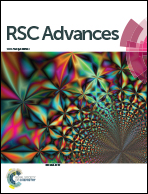Effect of the blocked-sites phenomenon on the heterogeneous reaction of pyrene with N2O5/NO3/NO2†
Abstract
To clarify whether the blocking reaction sites problem has a significant impact on heterogeneous reactions, experiments contrasting the order of pyrene (PY) particles' exposure to N2O5–O3 or O3–N2O5 in a heterogeneous process were conducted. Additionally, PY particles were exposed to N2O5 (∼8 ppm) in the presence of O3 (2.5–30 ppm) in a reaction chamber at ambient pressure and room temperature. Our results show that the phenomenon of blocking reaction sites may be ubiquitous on the surfaces of atmospheric aerosol particles, and the N2O5-initiated ionic electrophilic nitration may be promoted by NO3 radical-initiated heterogeneous reactions on the aerosol particle surface. We also found that the operative reaction mechanism strongly depends on the concentrations of the nitric oxides in the atmosphere. Our results provide an explanation as to why 2-nitropyrene (2-NPY), one of the most ubiquitous nitro-polyaromatic hydrocarbon pollutants that exists in both the gas and particle phases, was not observed in previous experiments on the heterogeneous reactions of PY and N2O5/NO3/NO2.


 Please wait while we load your content...
Please wait while we load your content...